Mongolia was one of the biggest points on my list when I was planning my trip through Asia. Just as many other people I talked with, I always had a picture of this country in my head, of pretty, vast and empty landscapes and endless possibilities to do outdoor stuff. So I was very excited when, after having spent 4 weeks in Russia, I finally arrived in Ulan-Ude, a russian city at the eastern side of Lake Baikal and the point where the Transmongolian Railway branches off the Transsiberian. From there, a train goes straight to Ulaanbaatar, the capital of Mongolia.
I had spent the previous 3 weeks around Lake Baikal, and most of the time I was camping, so in Ulan-Ude I just relaxed a bit and took a very urgently needed shower (which I didn’t have many of in the previous weeks). I walked a bit around the city, which is not super exciting but actually nice and quiet. The city is the capital of Buryatia, a Republic within Russia which is mostly inhabited by people that are closely related to the Mongols. For the first time, you could see more Asian looking people in the streets than people who looked European.
A thing the city is particularly proud of is the world’s biggest Lenin head… It is actually really big.

Early in the next morning, I finally boarded the train towards Mongolia and started the 24 hour journey to Ulannbaatar. Almost half of that time was spent at the border Russia-Mongolia border, where the train stops and spends endless amounts of time waiting for the custom procedures to finish. The train itself was a lot older than the russian trains and less comfortable, still OK though. During the train ride I could see the landscape changing from the siberian forests and mountains to the typical mongolian steppes.
Ulaanbaatar
Mongolia is a country that is kind of divided into two parts – the capital Ulaanbaatar, and the rest. Ulaanbaatar (or UB) is home to 50% of the mongolian population, around 1.5 million people, and (at least in the centre) a fairly modern city. It is also, as virtually all travellers who have been there will tell you, a pretty dull and unexciting place. It has an OK infrastructure and some minor sights, but it is clearly not the reason why tourists come to Mongolia. So it is no wonder that most tourists just come there, organize a tour to the more interesting parts of the country, stock up on supplies and then leave again. Obviously this is what I did as well, and in the following posts I will write a lot more about my trips through the country. Nevertheless, I spent some days there to do some organizational stuff and look a bit at the city.
Mongolia calls itself “The Land of the Blue Skies”, and it is in fact sunny most of the time. The sun can be quite burning, and in the summer it can get very hot. As soon as the sun is gone, it gets cold immediately however – when I arrived in late August, the night temperature in UB dropped to just above freezing already. One morning, I stood in the line at the chinese embassy where I applied for my visa, was freezing and at the same time suffering from a sunburn that I got the day before while I was walking through the very hot sun. While I stood there, I talked to some expats living in the city, who told me that in the summer the city is quite nice, while the winter is terrible. This is partly due to the temperatures, which can go down to -40°C, but mostly due to the pollution. They said that half the population in the city still lives in Gers (traditional yurt homes), and in the winter they heat with wood, coal, car tires or whatever else they can throw into their oven. Apparently in the winter the city is the most polluted city in the world.
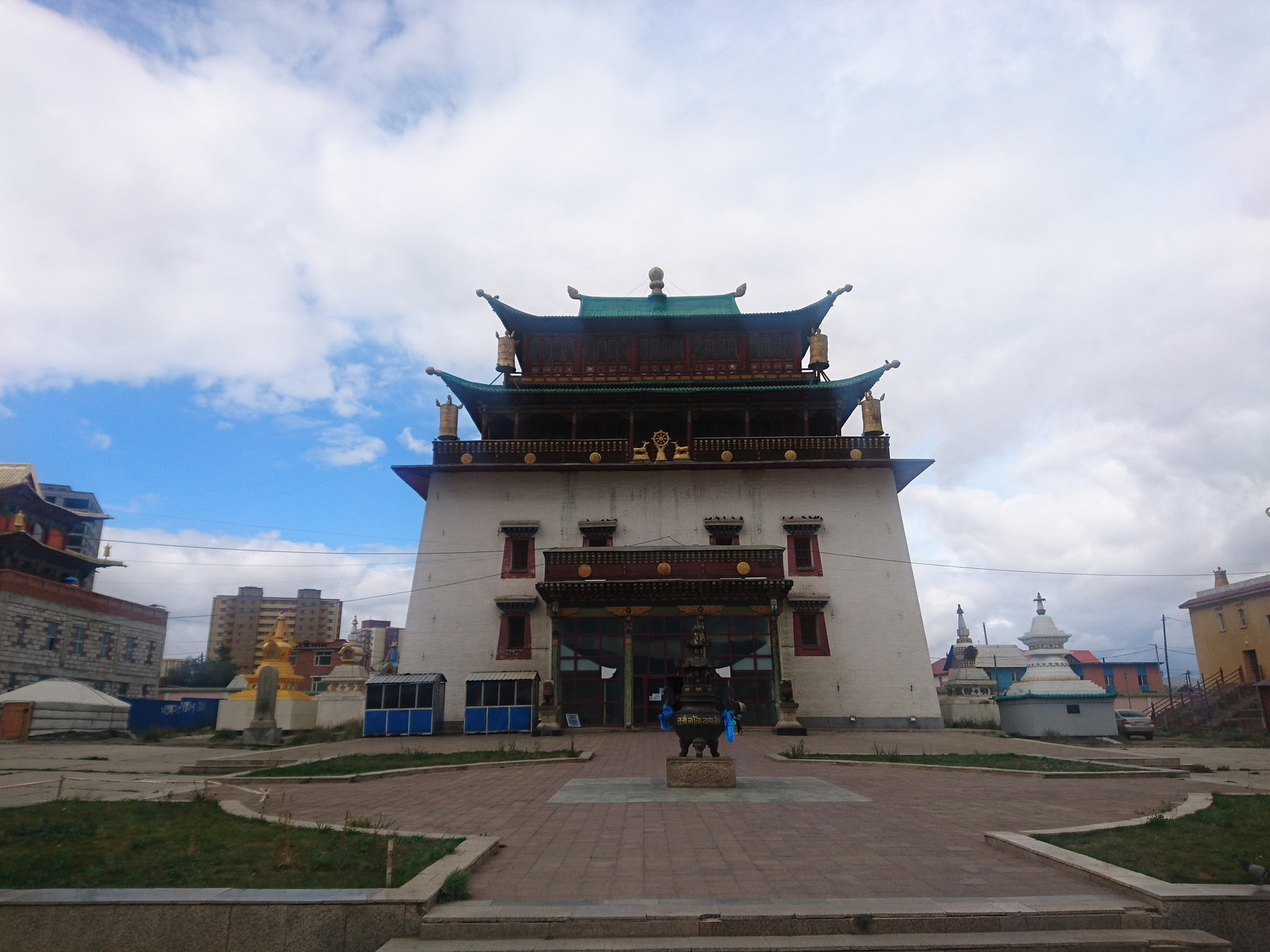
This is a big monastery complex in the city centre. Mongolia has been a buddhist country for a long time. However, it was a communist country for a long time as well (the country was formally independent, but actually completely dominated by the Soviet Union for as long as USSR existed), and since the communists where not exactly fans of religion, most of the buddhist heritage has been destroyed and many monks where killed. There are still a number of monasteries present however, and since the 90s many are reconstructed, so buddhist culture is something you can still see in many places, and practically every tour through the country visits at least one monastery (or at least ruins of one) at some point.
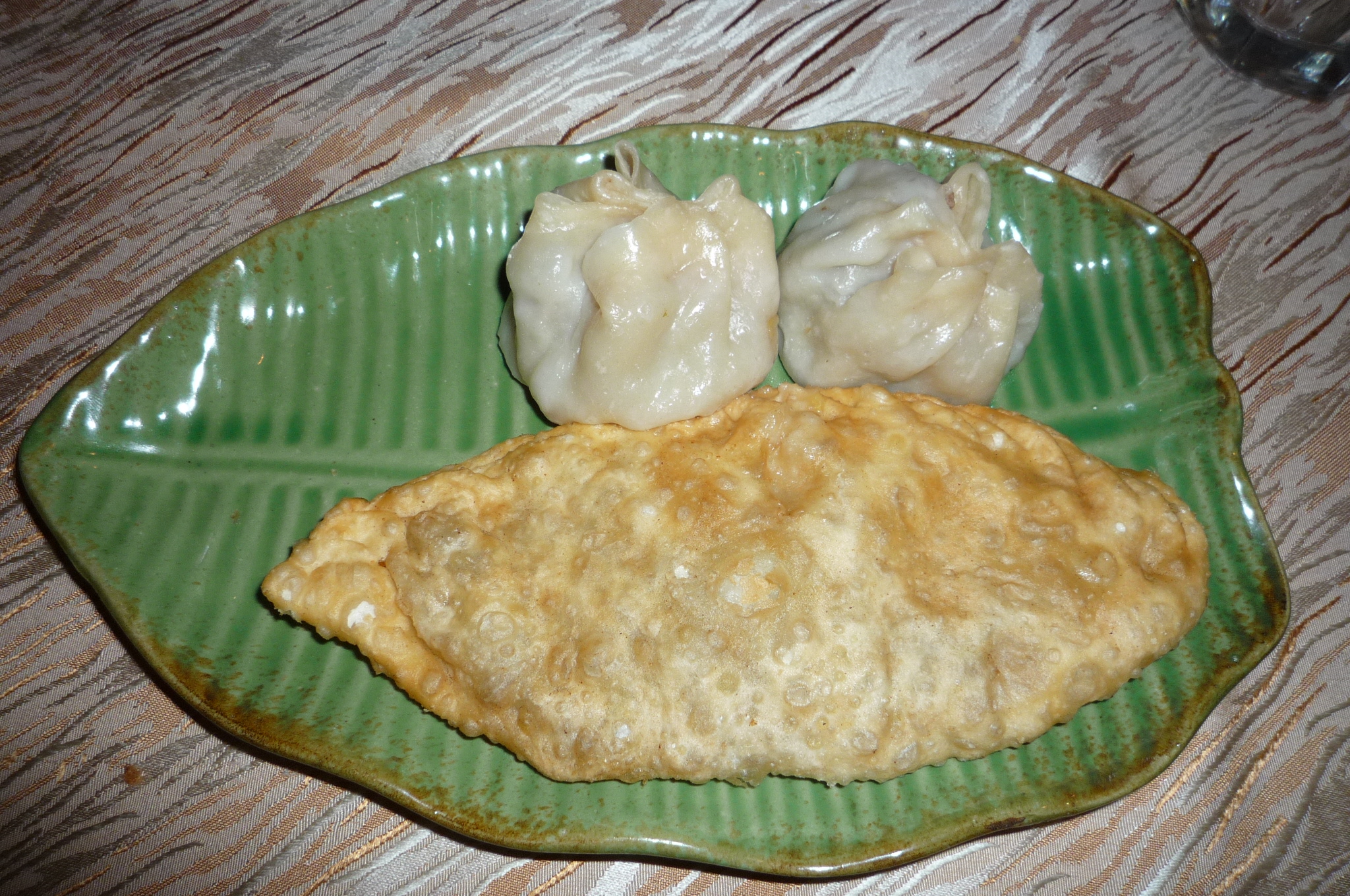
Mongolian Food: Buuz and Khushuur
I love exotic food, and when I travel, one of the most important things for me is to try the local food. So on the first day, I went to a mongolian restaurant to try the local stuff. In Germany, there is one “typical mongolian” type of restaurant: A Mongolian BBQ, where the special aspect is that you choose the raw ingredients and then you can watch the cooks while they grill your stuff. Apparenty this is hardly known at all here and is not a traditional thing at all. The Mongols where traditionally Nomads, living in the countryside and breeding animals. The steppe landscape with a lot of grass is good for raising livestock, but bad for growing vegetables, and you can see this clearly in the dishes: The food is very, very meat-based. The most common dishes are Buuz (steamed dumplings) and Khushuur (fried pancake), both filled with meat. The meat is mostly mutton. Other dishes are stir-fry noodles with meat or noodle soup with meat. Mongols also hardly use any seasoning at all, just a bit of salt and nothing else. Alltogether, I have to say the food is not very exciting and definitely not my taste (I think this is the first time that I have to say that about a countries cuisine…)
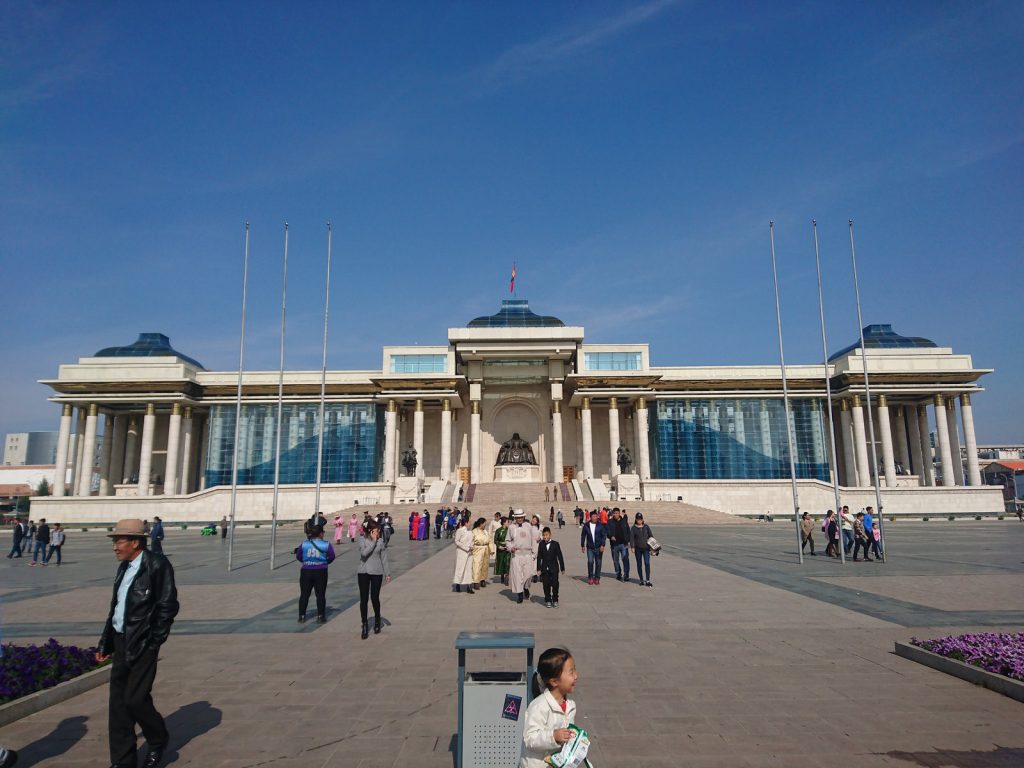
Ghengis Square
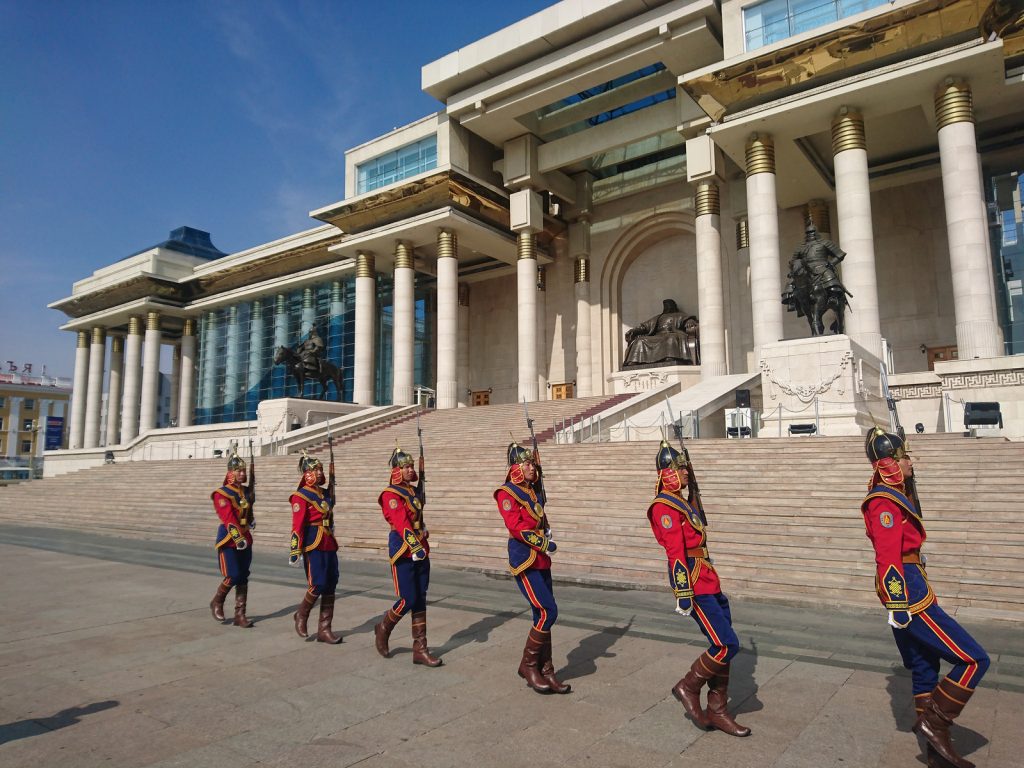
Parade of the guards, every day at noon
This is the main city square with the goverment building in the background. At the building, on top of the stairs, there is a huge statue of a fat guy sitting in a chair. This is probably the most famous mongolian who has ever lived and the only other thing that comes to people’s minds when they think about Mongolia apart from horses and nomads:
Ghengis Khan
Many people have heard this name and somehow know that at some point in the past, this guy was a great warrior and ruled a big empire, but I guess that is basically most of the common knowledge about him (at least that is what I knew before I came here). Since Ghengis Khan is kinda very important and defining for the countries history and identity, and because I found the whole story really fascinating, I will tell a little bit more about him here before I start with the interesting stuff about my trips in the following posts (you can skip the rest if you really don’t care about Ghengis Khan at all).

Ghengis Khan
Ghengis Khan (Khan is just the title for a mongolian leader, kinda like an emperor, his birth name was Temujin) was born around 1160 as part of the mongolian aristocracy, when the area that is today Mongolia was populated by different nomadic tribes. They sometimes worked together and sometimes fought against each other, but only when Temujin became Khan when he was around 30 most of them where united.
When Ghengis Khan became the leader of the Mongols, he introduced new ways of ruling. He gave power to people according to merit and loyalty, while before power was passed on through the families. When he conquered enemies, he rather integrated the defeated people into his tribe rather than killing the soldiers and enslaving or chasing away the civilians, as it had been done before. Through these new way of politics, he was able to quickly expand his power, and by 1206 he had become the sole leader of all tribes in the mongolian steppe and got the title Ghengis Khan.
After the tribes had been united, they couldn’t fight against each other anymore, so they had to search new enemies to fight against outside of their own area. They quickly turned against their neighbours to the east (what is China today) and to the west in Central Asia. No enemy was able to withstand the brutal and advanced warfare tactics of the Mongols, and by the time Ghengis Khan died in 1227, the empire spanned between the Pacific Ocean and the Caspian Sea, an area already twice as big as the Roman Empire.
After his death, his son Ögedei became the new Khan. He managed to expand the empire even more, and advanced towards Europe, getting as far as Poland, Hungary and Croatia (this was actually the first time in history that Europeans realized they have to work together and stop all their wars for some time to fight against the common enemy. Of course, they continued fighting against each other when the Mongols retreated). In the late 13th century, the Mongol Empire spanned between Korea in the east and Eastern Europe in the west, making it the biggest contiguous empire in world’s history.

Rise and Fall of the Mongolian Empire
However, as quickly as the empire rose to power, it fell again – Ghengis Khan’s grandchildren fought about who should be the legitimate successor to Ghengis and Ögedei, civil wars broke out and at the end of the 13th century, the grand empire had been fractured into several smaller empires which weren’t as strong anymore, and eventually the tribes retreated into their homelands in the steppe.
Although the empire didn’t last as very long, it is still somehow a defining aspect of the mongolian identity (still today, it is the only thing that most of the world knows about Mongolia today after all), and Ghengis Khan is today the undisputed national hero. Mongolians nowadays see him very positively. However, he was undoubtedly an extremely brutal person, responsible for mass murders etc, so outside of the country the perception is a lot less positive.
A few years ago, an hour or so outside of UB a big statue was built to commemorate him. It is a really, REALLY big statue. On the pictures you don’t really see how big it actually is, but you can actually go up inside it and walk on the neck of the horse. It is about 40 meters high, I think.
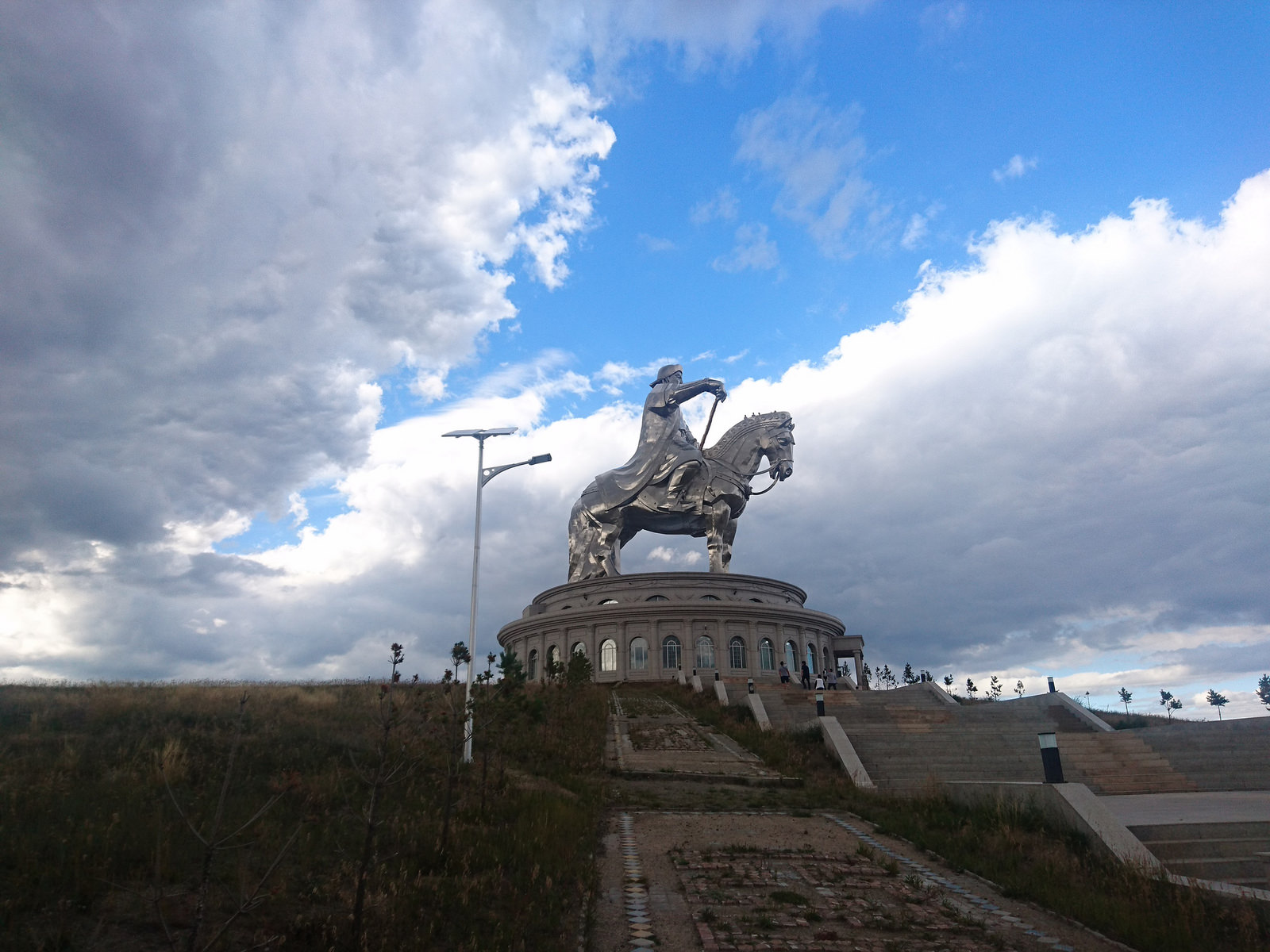

Ghengis Khan Statue